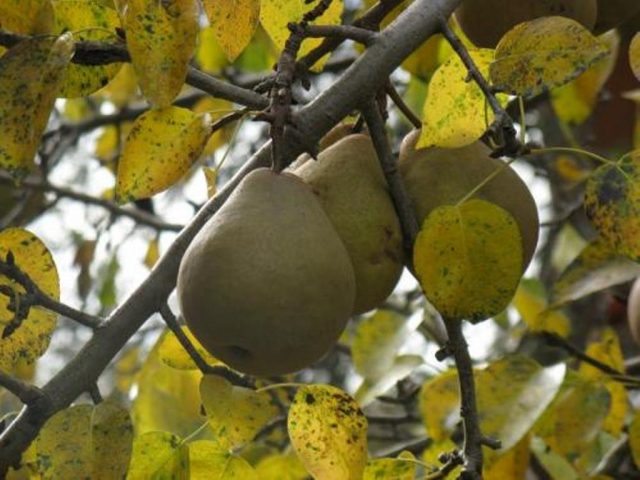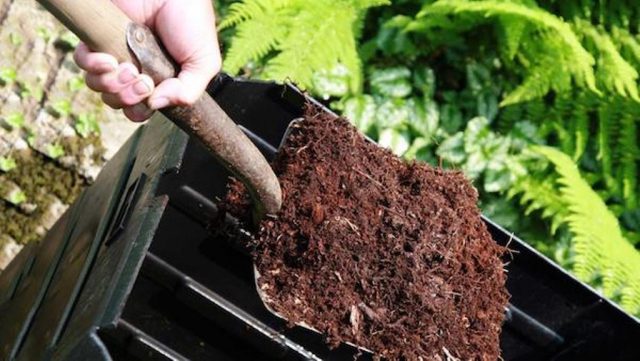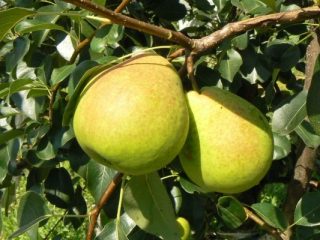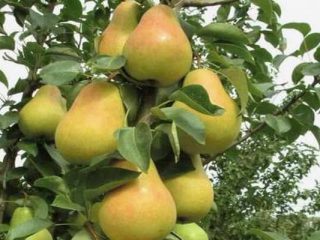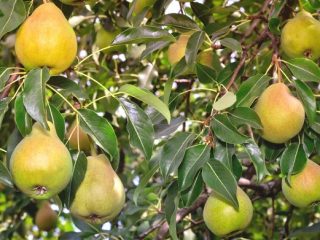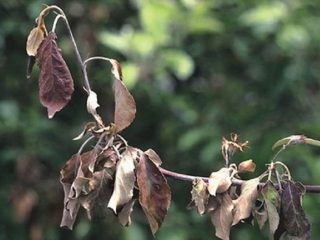Content
In order to grow a beautiful pear garden, you need regular and proper care. One of the main processes is feeding. Every gardener who grows fruit trees should know what fertilizer is needed for a pear in the fall. Timely, correct feeding is the key to a good harvest for the next season.
Why feed a pear in the fall
Pears are fed in spring, summer and autumn. Autumn feeding is especially important, since the yield and quality of the fruits depend on it. It is needed to compensate for the nutrients expended by the plant during growth and fruiting, as well as to increase resistance to winter cold. During low temperatures, an unprepared tree may die.
Features of autumn feeding of pears in winter
Autumn top dressing is applied to the trunk circle, retreating 60 cm from the tree trunk. It will allow the plant to store all the necessary nutrients for long wintering. For young seedlings, top dressing is applied through digging, 2 years after planting. If the soil was processed before planting, and the pit was fertilized according to the rules, the young tree is not fed.
If you do not make autumn feeding, then you can observe:
- decreased immunity;
- deterioration in the taste of fruits;
- shredding foliage.
Terms of autumn feeding
In the fall, the pear is fertilized 2 times. The first is after the fruit has been removed. For this, mineral complexes with nitrogen are used. Nitrogen is introduced to restore strength after fruiting, no later than the beginning of September. If nitrogen is added later, the plant will begin to actively grow green mass, which will adversely affect the tree in winter.
The second, depending on the region of growth, is applied from mid-September to mid-November, when the foliage turns yellow by more than 30%. During this period, peat, rotted manure or humus are introduced. This method not only enriches the pear with essential trace elements, but also becomes a warm pillow for the roots. The nutrient layer must be at least 15 cm.
How to feed a pear in autumn
A fruit tree can grow in one place for over 20 years. During this time, the root system sucks out all the juices and nutrients from the ground. Therefore, it is necessary to regularly apply top dressing. In autumn, the pear is fed with organic and mineral fertilizers.
Mineral fertilizers for pears in autumn
To grow a rich crop, chemical additives are needed. A correctly used dose will improve the yield, normalize the metabolic process, have a positive effect on the setting of flower buds and strengthen the immune system. For dwarf, columnar and undersized varieties, the dosage should be one third lower.
Potassium for pears is very important, especially before wintering. After all, this trace element helps the culture to endure the winter cold. It removes excess moisture from the cells, which leads to thickening of the juice.
Wood ash is a popular plant raw material, but it is rational to apply it only to heavy clay soil. The optimal dosage is 1 tbsp. for 1 sq. m. Wood ash is laid out under a pear tree, spilled abundantly, the soil is mulched with a 15 cm layer of straw, dry foliage, spruce needles or cones.
Of the finished preparations, the preparation "Kalimagnesia" is used.This top dressing contains not only potassium, but also magnesium. To dilute the fertilizer for 10 liters of water, add 20 g of the drug. The prepared solution is poured into the trunk circle. You can also use potassium sulfate, diluting it strictly according to the instructions.
Phosphorus is responsible for plant growth and development. The lack of a microelement affects the quality of the buds and further yield. Lack of phosphorus can be determined by untimely leaf fall and the small size of the leaf plate. For 1 sq. m. you need to add one of the drugs:
- simple superphosphate - 45 g;
- double - 30 g;
- granulated - 45 g.
The best result will be obtained by fertilizing the pits. For this, holes are dug around the trunk to a depth of 20 cm. The necessary dosage of top dressing is placed in each hole, sprinkled with soil, spilled and mulched.
Also, many gardeners use compound fertilizers. They are appreciated for their ease of use and good results. The composition includes not only phosphorus and potassium, but also a specialized component for the garden. The most popular preparations: "Fruit Garden", "Universal", "Autumn for horticultural crops". When using fertilizers, you must carefully read the instructions and follow the recommended dosage.
Most gardeners prepare complex mineral dressings on their own.
Option number 1
- potassium chloride - 1 tbsp. l .;
- superphosphate - 2 tbsp. l .;
- water - 10 liters.
All ingredients are mixed in warm water until completely dissolved. The prepared fertilizer is used to irrigate the trunk circle.
Option number 2
Use immediately after fruiting, before the first month of autumn.
- urea - 1 tbsp. l .;
- superphosphate - 2 tbsp. l .;
- potassium chloride - 1 tbsp. l .;
- phosphate rock - 1.5 tbsp. l .;
- ash - 2 tbsp.;
- ammofosk - 3 tbsp. l.
All ingredients are mixed and scattered at a distance of 60 cm from the trunk. After bait, the earth is spilled abundantly.
Fertilizing pears in autumn with manure
Organic fertilizers are the most reliable and effective fertilizers. An environmentally friendly crop cannot be grown without organic matter. Manure remains a favorite from ancient times to this day. The frequency of application depends on the age of the tree and on the fertility of the soil:
- up to 7 years - no more than 2 buckets per sq. m;
- over 8 years - 3-4 buckets.
Bird droppings are a lightweight option that can be applied dry under the pear. Dry granules are buried in the ground of the trunk circle and spilled abundantly.
Other organic fertilizers
Top dressing of pears in the fall can be done with other fertilizers, such as:
- ash from burning potato tops and sunflower mixed with humus;
- compost - laid out around the trunk with a thickness of at least 10 cm;
- siderates - sown in the near-stem circle in spring or autumn.
Top dressing rules
The main feature of fertilization is the bedding of the root system. Therefore, shallow grooves are made in advance, where mineral fertilizers dissolved in water are applied.
After fertilization, the soil is poured abundantly. If top dressing is applied in rainy weather, watering is not needed. To determine the degree of soil moisture, you need to take a clod of earth from a depth of 10 cm and squeeze it in the palm of your hand. If the earth has turned into a cake, then there is enough moisture in the soil, if it crumbles, abundant watering is needed. The watering rate is 2 buckets for 1 adult specimen.
Experienced gardening tips
Before fertilizing, you need to read the advice of experienced gardeners:
- Organics can be applied under a tree over 4 years old.
- Nutrients are assimilated within 3-4 weeks, therefore, it is pointless to add fertilizing before the start of frost.
- Before feeding, the pear is prepared: dry, broken branches and foliage around the trunk are removed.
- Clarification of foliage indicates a lack of nitrogen. Therefore, in mid-August, the pear can be fed with nitrogenous fertilizers. The main thing is to observe the dosage, otherwise the plant may winter badly, and in the spring a large amount of foliage will bloom on the tree to the detriment of the harvest.
- If the pear is not fed with phosphorus in the fall, it will not release foliage and will not form fruit.
- If by the end of summer the foliage has curled up, covered with spots, it means that the supply of potassium has dried up. It is this mineral that a pear will especially need in winter. And if the foliage turns pale, and turns purple around the edges, it means that the plant lacks magnesium and you need to use complex mineral fertilizing.
Conclusion
Correctly applied fertilizers for pears in the fall are the key to a high yield of tasty and aromatic fruits. The main thing is not to rush, but to show endurance, conscientiousness and observe the dosage.
